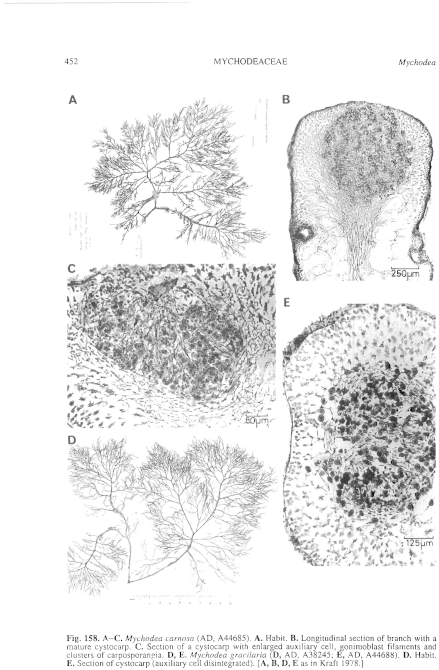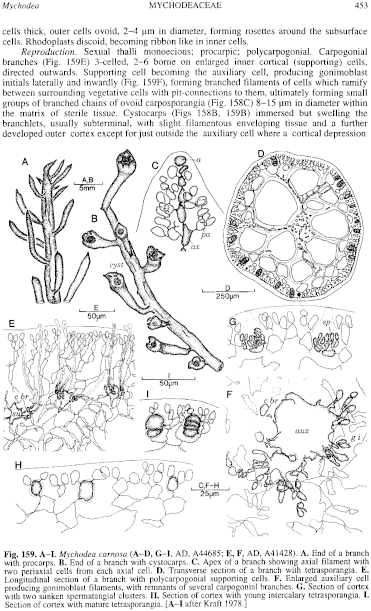|
|
|
|
|
|||||||||||
|
Electronic Flora of South Australia Species Fact Sheet
Phylum Rhodophyta – Class Florideophyceae – Order Gigartinales – Family Mychodeaceae
Selected citations: Kraft 1978: 520, figs 2–4, 29–31.
Synonyms
Cystoclonium carnosum (Hooker & Harvey) J. Agardh 1851: 309.
Mychodea membranacea Hooker & Harvey 1847: 408. Harvey 1860a: 323. Kützing 1849: 723. Lucas & Perrin 1947: 156.
Cystoclonium membranaceum (Hooker & Harvey) J. Agardh 1851: 308.
Mychodea terminalis Harvey 1860a: 323. J. Agardh 1876: 570; 1897: 50. Kylin 1932: 64. Kützing 1866: 26, pl. 75a, b. Lucas & Perrin 1947: 156, fig. 26.
Gigartina longipes Kützing 1859: 35, pl. 84 fig. 2.
Mychodea longipes (Kützing) J. Agardh 1897: 50. Kylin 1932: 64.
Mychodea mallardiae Kützing 1866: 27, pl. 77c, d.
Thallus (Fig 150A) medium to dark red-brown, 10–30 (–40) cm high, much branched irregularly radially with long axes 3–4 mm in diameter and main branches, with progressively slenderer and shorter laterals, the branchlets (Fig. 159A, B) usually tapering abruptly to a point and often basally constricted. Holdfast crustose, knobby, 2–5 mm across; epilithic or on solid substrata or epiphytic Structure uniaxial with a prominent apical cell and each axial cell forming two periaxial cells (Fig. 159C) and filaments, soon producing cross-connector cells and a filamentous central medulla (Fig. 159D) with the axial filament indistinguishable, surrounded by the large-celled outer medulla (with abundant secondary pit-connections) derived from inner cells of the periaxial filaments; cortex small-celled, 2–4
cells thick, outer cells ovoid, 2–4 µm in diameter, forming rosettes around the subsurface cells. Rhodoplasts discoid, becoming ribbon like in inner cells.
Reproduction: Sexual thalli monoecious; procarpic; polycarpogonial. Carpogonial branches (Fig. 159E) 3-celled, 2–6 borne on enlarged inner cortical (supporting) cells, directed outwards. Supporting cell becoming the auxiliary cell, producing gonimoblast initials laterally and inwardly (Fig. 159F), forming branched filaments of cells which ramify between surrounding vegetative cells with pit-connections to them, ultimately forming small groups of branched chains of ovoid carposporangia (Fig. 158C) 8–15 µm in diameter within the matrix of sterile tissue. Cystocarps (Figs 158B, 159B) immersed but swelling the branchlets, usually subterminal, with slight filamentous enveloping tissue and a further developed outer cortex except for just outside the auxiliary cell where a cortical depression remains; ostiole absent. Spermatangia in scattered clusters (Fig. 159G) in the outer cortex, with cortical cells producing a ring of 4–6 initials, each cutting off two elongate spermatangia 2–3 µm in diameter.
Tetrasporangia (Fig. 159I) scattered, transformed from mid cortical cells, originally bearing outer cortical cells and thus intercalary (Fig. 159H), ovoid, 28–35 µm long and 15–20 µm in diameter, zonately divided.
Type from Georgetown, Tas. (Gunn); lectotype in Herb. Hooker, BM.
Selected specimens: Port Denison, W. Aust., drift (Kraft, 14.xii.1971; AD, A44684). Hopetoun, W. Aust., drift (Gordon, 20.xi.1968; AD, A34135). Egg I., Isles of St Francis, S. Aust., 32–38 m deep (Shepherd, 11.i.1971; AD, A38115). Avoid Bay, S. Aust., drift (Womersley, 30.xi.1975; AD, A46834). Investigator Strait, S. Aust., 31 m deep 35°28'S, 137°17E (Watson, 23.i.1971; AD, A41121). Tapley Shoal, S. Aust., 15 m deep (Shepherd, 2.ii.1969; AD, A33514). Port Noarlunga, S. Aust., 24 m deep (Ottaway, 3.ii.1981; AD, A52094). Vivonne Bay, Kangaroo I., S. Aust., 1–4 m deep on jetty piles (Kraft, 3.xii.1971; AD, A41428) and 2–5 m deep on piles (Kraft, 6.iv.1972; AD, A44685). Robe, S. Aust., drift (Womersley, 20.xii.1953; AD, A19121). Observation Point, Port Phillip, Vic., 4 m deep (Macpherson, 18.i.1959; AD, A23176). Walkerville, Vic., drift (Sinkora A1569, 23.ii.1972; AD, A43123). Bombay Rock, Tamar Est., Tas., upper sublittoral (Womersley, 27.i.1949; AD, A10378). Great Taylor Bay, Bruny I., Tas., 10 m deep (Shepherd, 7.ii.1970; AD, A35290).
Distribution: Port Denison, W. Aust., to Walkerville, Vic., and around Tasmania.
Taxonomic notes: The structure and reproduction of M. carnosa, and the synonymy, have been described in detail by Kraft (1978, p. 520), who considers that records of this species from outside southern and western Australia are probably incorrect.
Recent collections by Kraft indicate that further study of the carnosa complex is needed. Currently two species may be confused, one largely epilithic with fleshy axes, a thick often lobed holdfast and knobby cystocarps, and the other epiphytic on seagrasses, slender and firmer with thin crustose holdfasts, and slightly swollen terminal cystocarps.
References:
AGARDH, J.G. (1851). Species Genera et Ordines Algarum. Vol. 2, Part 1, 1–336 + index. (Gleerup: Lund.)
AGARDH, J.G. (1876). Species Genera et Ordines Algarum. Vol. 3, Part 1 - Epicrisis systematis Floridearum, pp. i-vii, 1–724. (Weigel: Leipzig.)
AGARDH, J.G. (1897). Analecta Algologica. Cont. IV. Acta Univ. lund. 33, 1–106, Plates 1, 2.
HARVEY, W.H. (1860a). Algae. In Hooker, J.D., The Botany of the Antarctic Voyage. 111. Flora Tasmaniae. Vol. II, pp. 321–343, Plates 185–196.
HOOKER, J.D. & HARVEY, W.H. (1847). Algae Tasmanicae. Lond. J. Bot. 6, 397–417.
KÜTZING, F.T. (1849). Species Algarum. (Leipzig.)
KÜTZING, F.T. (1866). Tabulae Phycologicae. Vol. 16. (Nordhausen.)
KRAFT, G.T. (1978). Studies of marine algae in the lesser-known families of the Gigartinales (Rhodophyta). III. The Mychodeaceae and Mychodeophyllaceae. Aust. J. Bot. 26, 515–610.
KYLIN, H. (1932). Die Florideenordnung Gigartinales. Lunds Univ. Årsskr. N.F. Avd. 2, 28 (8), 1–88, Plates 1–28.
LUCAS, A.H.S. & PERRIN, F. (1947). The Seaweeds of South Australia. Part 2. The Red Seaweeds. (Govt Printer: Adelaide.)
The Marine Benthic Flora of Southern Australia Part IIIA complete list of references.
Publication:
Womersley, H.B.S. (14 January, 1994)
The Marine Benthic Flora of Southern Australia
Rhodophyta. Part IIIA, Bangiophyceae and Florideophyceae (to Gigartinales)
Reproduced with permission from The Marine Benthic Flora of Southern Australia Part IIIA 1994, by H.B.S. Womersley. Australian Biological Resources Study, Canberra. Copyright Commonwealth of Australia.
Illustrations in Womersley Part IIIA, 1994: FIGS 158 A–C, 159.

Figure 158 enlarge
Fig. 158. A–C. Mychodea carnosa (AD, A44685). A. Habit. B. Longitudinal section of branch with a mature cystocarp. C. Section of a cystocarp with enlarged auxiliary cell, gonimoblast filaments and clusters of carposporangia. D, E. Mychodea gracilaria (D, AD, A38245; E, AD, A44688). D. Habit. E. Section of cystocarp (auxiliary cell disintegrated). [A, B, D, E as in Kraft 1978.]

Figure 159 enlarge
Fig. 159. A–I. Mychodea carnosa (A–D, G–I, AD, A44685; E, F, AD, A41428). A. End of a branch with procarps. B. End of a branch with cystocarps. C. Apex of a branch showing axial filament with two periaxial cells from each axial cell. D. Transverse section of a branch with tetrasporangia. E. Longitudinal section of a branch with polycarpogonial supporting cells. F. Enlarged auxiliary cell producing gonimoblast filaments, with remnants of several carpogonial branches. G. Section of cortex with two sunken spermatangial clusters. II. Section of cortex with young intercalary tetrasporangia. I. Section of cortex with mature tetrasporangia. [A–I after Kraft 1978.]

|
Email Contact: State Herbarium of South Australia |

|